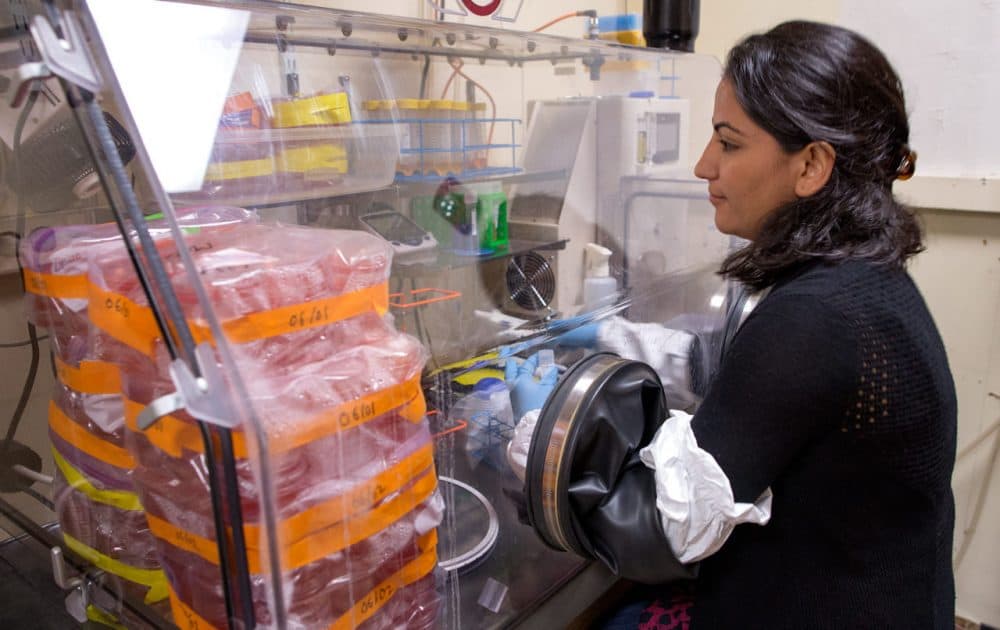Advertisement
In Test Tube, 'Pulse-Doses' Of Antibiotic Wipe Out Lyme Disease Bacteria Persisters
Resume
From the Northeast to the Midwest and beyond, it’s high season for Lyme disease. An estimated 300,000 Americans are diagnosed with the spreading, tickborne disease every year. Most can be successfully treated with antibiotics, but for some, symptoms persist for months and even years — pain, fatigue, arthritis.
For me, Lyme disease news tends to range from horrifying — stories of insidious, life-ruining symptoms — to just depressing, like recent speculation that New England’s massive snowfall this winter may have insulated ticks and helped them survive.
So, though it’s still extremely early research, I was gladdened by a report just out from Northeastern University that a prominent germ-fighting scientist may have found a new way to kill off Lyme disease bacteria even when it persists after antibiotics. In test tubes, at least.

Prof. Kim Lewis, chief of Northeastern’s Antimicrobial Discovery Center, made a big splash just this January in the journal Nature with the discovery of a potent new antibiotic.
Now, he reports finding not a new compound but a new anti-Lyme timing regime for dosing of antibiotics.
"We decided, ‘OK, let’s look at, what are the potential vulnerabilities of this seemingly invincible pathogen?” he says. “It has all these strengths, but what are its vulnerabilities?”
That powerful pathogen is Borrelia burgdorferi, the Lyme disease bacterium. Until recently, Lewis did not include it in his research repertoire. But a couple of years ago, he was invited to a conference on Lyme disease, and unlike his usual scientific gatherings, it included some long-suffering patients.
“That probably was a tipping point,” he says, “that suggested to me that we should really get into this, and maybe try to do something.”
Lewis had long researched other hard-to-eradicate infections. “What we found, and published over the years," he says, "is that in chronic infections, you have a small subpopulation of dormant, spore-like cells — these are called persisters,” he says. “So when antibiotics kill off the regular cells, persisters survive to live another day.”
"Of course, the word of caution is, this was in the test tube. It has not been tested in animals, nor has it, obviously, been tested in humans."
Dr. Harriet Kotsoris, Global Lyme Alliance
There’s long been debate about whether the long-lasting symptoms that some Lyme patients experience could stem from Borrelia persisters, somehow hiding out in the body. Lewis had seen how latent tuberculosis could lie low. He suspected Lyme disease might be similar, and decided to look at persisters.
His research team attacked some Borrelia with antibiotics and then waited...and waited...a very long time in the world of bacteria — three weeks. They found that with time, regular cells were killed but persisters remained completely intact.
“That was expected,” Lewis says. “Also satisfying, that this may be an important culprit explaining at least part of the difficulty of treating Lyme disease.
Once he'd homed in on the persisters, Lewis wanted, naturally, to obliterate them. His team tried several compounds that had worked on persisters in other bacteria — in staph, for example, and E. coli — but with no luck.
The work was starting to look like a dead end — unless the researchers could find some chink in this elusive bug’s armor.
They focused on a possible weak point: You can attack Lyme bacteria repeatedly with antibiotics and it won’t develop antibiotic-resistant “superbugs.” So they decided to tinker with the dosing; to apply antibiotics, wait for the persisters to wake up, and quickly hit them again with the drugs. And do that again. And again, four times in all, in a regime they call pulse-dosing.
Inside a special chamber that keeps the oxygen low to help the bacteria grow, graduate student Bijaya Sharma added an antibiotic, ceftriaxone, to test tubes containing Lyme disease bacteria. Then she spread the mixture on Petri dishes.
Normally, she would see white dots on the dishes, growing colonies of bacteria. But after the pulse dosing regime, she saw none.
"I repeated it and I saw the same results. So I had to believe it. It was true."
grad student Bijaya Sharma
“At first I could not believe it and I thought I had to repeat it, of course,” she says. “So I repeated it and I saw the same results. So I had to believe it. It was true.”
The Northeastern researchers published the results this month in the journal Antimicrobial Agents and Chemotherapy. They’re now planning to collaborate on studies to test the dosing regime in animals and humans.
The findings look very promising, says Dr. Harriet Kotsoris, chief scientific officer of Global Lyme Alliance, which funded the research. "Of course, the word of caution is, this was in the test tube, it has not been tested in animals, nor has it, obviously, been tested in humans."
The dosing schedule that the Lewis lab used, she notes, is very different from what some doctors have been prescribing Lyme disease patients for years.
Some have used a pulse approach, she says, "because we’ve known for a long time that these bacteria go into hiding, and it was just a common-sense concept that you let them go dormant and when they come back up again, you hit them again."
But "the 'off' period may have been too long in humans," Dr. Kotsoris says, and that could be why the pattern didn't help some patients.
"So again, I think it’s very early," she says, "but I don’t think it’s that far away. Believe me, we at Global Lyme Alliance sense everybody’s sense of urgency and desperation and need for some more answers in terms of chronic Lyme disease. But I think, for now, we should proceed a little bit conservatively, and let Dr. Lewis finish his work — because he is going on to animal studies to verify that concept."
How soon might his findings affect clinical practices? Lewis says that because a clinical study in humans would not be held up by the need for approval of any new drugs, it may be possible to formulate better drug regimens within a couple of years.
(And for now, as always, public health officials are reminding the public to try to avoid Lyme disease by using tick repellent and checking for ticks after being outdoors. More information at Tickencounter.org and the CDC.)
